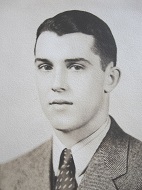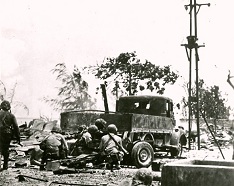
|
World
War II |
|
Part 3 of 4 - A Memoir of Wartime By James Melvin Younkin |
|
James Melvin Younkin Sr. |
Last month: Mel makes money running clandestine non-military operations (better known as a poker game in the ship's laundry) ... and decides that excessive facial hair is not the best way to attract dance partners.
In a convoy we sailed seven days, then landed at Havana Bay (Efate) in the New Hebrides. In addition to the Second Marine Division, which had come on in New Zealand, we took on more personnel and supplies. Other ships joined the convoy, and on November 13, 1943 our armada left, again heading north.
On the 19th of November, a lonely Japanese four-motor bomber came flying over. We fired a few rounds of shells at him but he was too high for us to do any damage.
We found out later that it was a Japanese reconnaissance plane. So, the Japanese knew we were coming. The next morning, we were getting ready for our big landing on Tarawa in the Gilbert Islands.
Although the Navy pounded the beaches of Tarawa with a heavy assault carrier air and naval gun bombardment, the attacking Marines ran into unexpectedly fierce and determined opposition.
My battle station assignment was to be a gunner on a 20mm anti-aircraft gun located on the flying bridge port side. Something I will not forget the rest of my life was seeing the men loaded with fighting gear climb aboard the landing craft. These brave men did not know if they would survive this bloody battle, or be among the casualties.
For four days we manned our general quarter stations, eating cold bologna sandwiches and sometimes hot coffee. Only a few Japanese planes came over and we made short work of them. There were a few engagements between the planes and ships. After the second day a boatswain and the ship's chaplain spent all day in a small boat taking care of the dead American soldiers floating around the ship.
After the beach was secure, we unloaded troops and supplies at Tarawa, then returned to Pearl Harbor, arriving December 4, 1943.This was a warm-up for the landing ahead of us. I guess the Navy thought they needed different methods of landing troops, because after practice in Hawaii, we went to San Diego for more landing practice from January 1 to January 13, 1944.
Things were not always serious during the war. Once the gunnery crew made some "raisin jack," potent nearly non-potable liquor made from fermented raisins. The men stored this under the 20mm guns. The innovative Yanks brewed up their raisin jack in the wooden kegs that syrup came in.
One day the captain had inspection and asked to check the ammo cabinet. Warm air rushed into the cabinet and blew up the kegs of raisin jack that were brewing inside. The gunner's crew was put on report, and no more raisins were allowed on board our ship.
The LaSalle had an eight-piece ship band, which consisted of saxophones, drums, clarinets and a trumpet. The sailors danced with each other. To relieve boredom, the ships would set up boxing matches, with each ship having its own boxer to fight against other ship's favorites. We also watched movies, played cards, and listened to Tokyo Rose play our favorite music.
When the hold was empty, we would play basketball, half court only. When the ship moved, it was hard to make a basket.
Bob and I ran an "anchor pool" for awhile letting people bet on when we would weigh anchor. We would seal 60 envelopes numbered 1 to 60 at one dollar each. Eventually, the captain noticed that it was always either Bob or I who won the game, so he closed us down. We still ran the poker games, and devised other ways to make money.
While we were at port, Skipper E.M. Doar, Jr. saw a jeep on the San Diego dock. He had a boatswains mate pick the vehicle up with a crane and bring it aboard. The jeep was cleaned and repaired. Then it was repainted, and new numbers were put on the side.We kept the jeep on our ship.It would come in handy later.
Some of the guys did not like the second in command, Officer Bisek; he was Jewish. It did pay, however, to have Bisek on your side. Bob told Bisek that "Younkin" was just shortened from a longer Jewish name, "Younkinstein," and that I was actually Jewish. So when Bob and I wanted liberty, we would ask Bisek, who always said, "Yes."
The supply officer, Healy, did not like Bob and me too much. One day Healy did not want to sign the request chit for leave.
"Why can't we go?" Bob asked. "Do you think we have a stolen washing machine in our seabags?"
Request was denied. Not to be thwarted, we went to see Bisek and explained that we were due leave, but Healy would not sign our form.
"The S.O.B. supply officer wouldn't get out of his bunk at night to sign our chits," we complained.
"Well, of course you can go, fellows," Bisek said, signing our forms for shore leave. Good ol' Bisek, he always came through for us. Bob and I would not be denied our shore leave.
Next, it was back to Lahama Roads, Hawaii where we picked up some troops to haul back to the states. We made stops at Pearl Harbor, and Maui before returning to Frisco. Our ferryboat then went back to Hawaii, and returned to San Pedro. Enough was enough of this running around. I was sure that the captain wanted to see some action. We wanted a chance to show off all the landing techniques we had learned. It was May 1944, and we wanted to see some action.
There were some islands left in the Mariana group that had to be taken back from the Japanese. Our assignment was Eniwetok, north of Truk. The Army had their chance to perform a good landing on this island, and the U.S. Navy carrier planes had done a good job of bombing the island to soften it up for the soldiers. The 27th infantry division required two and a half days to subdue the island of Inewetok.
|
|
|
Marines landing on Saipan, June 1944 |
This landing was the start of the U.S. troop clean up of the Marshalls group, a thousand-mile advance through the Marianas. A week later, June 15, to June 23, 1944, we landed some well-seasoned troops on Saipan.
On Saipan, the two Marine divisions succeeded in linking their positions by taking Charan Karoa and Point Afetna. There was much artillery counter battery work as well as fighting on the ground.
On the 17th the U.S. 27th Infantry Division is landed on Saipan to reinforce the American advance there.
|
Marines fighting on Saipan |
There was a mix-up here, and for some reason our ship was thought of as a hospital ship. We wound up with several wounded Japanese soldiers and a geisha girl. The Captain had to explain to the Army medics that we had blood for U.S. troops, not Japanese, so "get them off my ship!" he said. The wounded prisoners were removed.
We were at our battle stations for days and nights. The cooks would bring us sandwiches and coffee and we would sleep anywhere we could. Dawn was when most of the action would happen. As the sun would come up, so would the Japanese planes. They would fly low and position themselves so they would be in the glare of the sun as we squinted upward. Coming in like this, the planes would be upon us before too many shots could be taken.
Because the war was winding down, there were some suicide planes called Kamikaze. These flying bombs did much damage to U.S. ships. Young, brave Japanese men, mostly unskilled pilots, had volunteered to make a one-way flight to death, aiming themselves at Navy ships. They assumed the title of Kamikaze, after the "divine wind" that scattered the Mongolian invaders who sent a fleet into Japan in the year 1281.
I saw a ship about 200 yards ahead of us get hit by a plane. The ship was lucky that the plane crashed into the side of the ship doing very little damage. A Coast Guard cutter much further away was hit in the flying bridge, killing 40 and wounding many more. Some wounded GIs were brought aboard; most died. We buried nine in one day at sea. Those four days of battle made this country boy a full-fledged sailor in wartime.
Next month: After R&R in Hawaii, Mel's ship goes into action at Guadalcanal; later, he celebrates the end of the war with a good nap.
Copyright ©
1998 James Melvin Younkin and Diana (Younkin) Egan.
Published on Minerd.com with permission.


